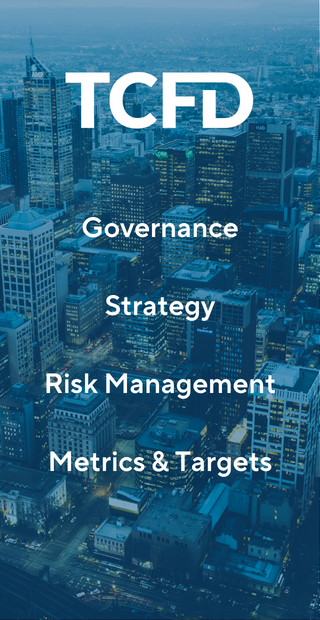Introduction
It is no secret that climate change is presenting a financial risk to the global economy. Both physical and transition risks pose a material impact on a company’s value and its assets. There is also an ever-increasing focus on Environmental, Social and Governance (ESG) factors by investors and other stakeholders which has spurred a wave of sustainability standards and frameworks across various industries.
However, we want to talk about one key framework in particular; the Taskforce on Climate-related Financial Disclosure (TCFD). It is a relatively new reporting framework for businesses and more importantly, has become mandated in the UK for large companies to report on for the 2022/2023 financial year. Complying with the TCFD recommendations will reduce the companies’ liability risk in several ways.
Four Pillars of TCFD
As this year will be a first for most companies, there are bound to be a few challenges with its adoption. In this article, we outline what we have learned the common pitfalls to be from helping multiple companies with their reporting, and how these pitfalls can be avoided. Firstly, the 4 main pillars of the TCFD disclosure framework should be summarised:
1. Governance – The disclosure of how governance relates to climate-related risks and opportunities. It is imperative to understand how a company’s leadership and board are involved in managing and assessing climate-related issues.
2. Strategy – The disclosure of actual and potential impacts of climate-related risks and opportunities on the organisation’s strategy and financial planning. Businesses should describe how resilient their strategies are to climate-related risks under different climate scenarios.
3. Risk Management – Typically a traditional Enterprise Risk Management (ERM) process to identify, assess and manage risks. Organisations are beginning to apply this process to climate-related risks, but this method still needs to be refined.
4. Metrics & Targets – Disclosure of metrics and targets used by the organisation to assess and manage climate-related risks and opportunities. Organisations can experience substantial added value from astutely measuring and managing performance related to climate issues and incorporating learnings into their business plans.
Pitfalls to Avoid and Their Solutions
Pitfall 1
Lack of Structure and Governance
There is often a lack of clarity on who is responsible for the company’s sustainability and ESG strategy. Companies may lack the necessary governance needed to report and measure on climate risks. This lack of structure often includes no clear management accountability, an inadequate reporting structure and insufficient buy-in from the board. This limits the opportunities for constructive ESG strategies and increases the risks of any exposure to climate change.
Solution: Establish Accountability
Transitioning towards better Governance on climate-related risks and opportunities is no easy feat. However, with the TCFD deadline looming there is no better time to thrash out the detail. A clear management structure needs to be established that tackles all challenges head on, good and bad. All business activities impacted by climate change must be accurately assessed, reported to a person with agency, and the responsibility for proactive or corrective action must be unequivocally in black and white. To ensure the highest chance of success you should carry out a skills gap analysis to identify where you need the most support.
Pitfall 2
Inadequate Data for Scenario Analysis
Companies often fail to report on climate risks as they may be missing the relevant data required to conduct and comply with the TCFD recommendations. When it comes to climate scenario analysis, the base case or business-as-usual scenario is frequently missing key pieces of information that help inform the strategy. This is often due to poor information provided by asset managers or lack of guidance on what data to use. Whether this is done internally or via a third party, a patchy analysis can lead to analytical oversight which will result in a poor understanding of relevant timing and hazards. Ultimately this will lead to unsuccessful long-term investments and business strategy.
Solution: Dive into the Detail
The best way to overcome this common pitfall is to bite the bullet and spend the requisite time deep diving into the detail of all your business’ data. To fill in the blanks in your data, you can perform a data gap analysis and find the knowns and unknowns, from the get-go. There is various different climate modelling software that can be utilised to develop reference points, thresholds and internal controls, and they can also help improve the completeness and accuracy of your base case data. An early start is beneficial as data gathering and improvement takes more time than you think and so those who engage with the TCFD regulatory guidance earliest will likely deliver the most successful strategy.
Pitfall 3
Unrecognised Risks
Climate risks need to be understood and recognised from the start. Poor understanding of the nature of climate risks and their integration into the overall risk management system usually means meaningful disclose is unlikely. This poor integration can lead to unidentified harm to the environment and climate risks that will have business impacts in the long-term.
Solution: Don’t Shy Away
There is no doubt that teasing out the nature of the risk to inform decision making is difficult. But climate-related risks must be integrated into your wider policies no matter how challenging it might be. There is a certain amount of climate change ‘baked-in’ to our current pathway and inference isn’t enough to evaluate them. Once understood climate risks should be embedded in the standard company risk management strategy and not be treated separately or siloed. This will guarantee that these risks are monitored and managed effectively as standard. It is also important to have effective communication lines with relevant stakeholders to provide clear messaging regarding risk identification and its management. It may be that various climate risks will not impact your business, however without adequate evaluation and demonstrable ‘workings’ that have informed your management strategies, relevant parties may not be assured and confident in your approach.
Pitfall 4
Disclosing Metrics and Targets
With the TCFD framework in effect you will need to disclose your metrics and targets according to the requirements of the regulations. It is often the case that irrelevant or vague metrics are used and there is a failure of communication as to how gaps in data will be closed. This leads to an inability to set relevant targets and disclose meaningful information. For example including narrowly focused or unrealistic carbon reduction targets that are not aligned with industry standards and functional methodologies will be a meaningless exercise.
Solution: Make Informed Choices
Disclose all the metrics and targets outlined in the TCFD framework and be specific about your monitoring and evaluation plan. The choice of metrics should reflect the data quality and should follow the guidance of the ‘Strategy’ pillar of the TCFD guidance. By conducting a materiality assessment, you can inform the selection of the best metrics which will allow you to monitor material themes and integrate them into the wider business strategy. Effective monitoring (for better or worse), robust communication which discloses the appropriate metrics, and near-term and long-term targets is the only way to satisfy the needs of stakeholders over the longer term and avoid excessive and credibility undermining revisions later down the line.
Eight Versa TCFD Case Study
The TCFD recommendations are aimed at guiding companies on how to produce consistent, comparable, and reliable climate-related information. Below is an example of our work on TCFD alignment with a leading health-tech company.
Eight Versa worked with a leading healthcare technology company to enhance its ESG strategy and devise a roadmap to becoming carbon neutral by 2030 in line with the Paris Agreement targets. We mapped out investor expectations, assessed the client’s emissions across scopes 1, 2 and 3 and identified key areas of improvement for their wider sustainability strategy.
Even though the TCFD recommendations are widely adoptable and applicable, interpretation of the key disclosures and how to report them is a crucial part of the process. One of the main aspects of our work focused on examining the clients’ entire risk management and governance processes through a climate-focused lens. We helped the client perform a climate resilience analysis on their portfolio of assets with our technology-enabled scenario modelling tool to identify any material climate risk across the business. We assessed climate hazard risk exposure on the client’s portfolio of assets using a risk matrix with hazard-specific risks and flood analysis under 3 different climate scenarios; Business as Usual, Emissions Peak in 2040 and Paris-aligned. Through this analysis, we helped the company to integrate forward-thinking data into its risk management processes.
If you would like to know more about TCFD or how we can support you through the recommendations, feel free to get in touch.
Chris Hocknell, Director
Chris brings over 17 years’ experience of supporting the built environment and corporate world with their sustainability goals. Specialising in sustainability strategy development, Chris works closely with clients to assess and understand their carbon and environmental footprint.







